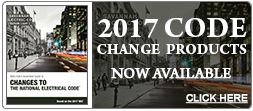NEC - History and Purpose (9-8-99)
"Let The Code Decide"
ANYONE who has anything at all to do with the electrical industry is familiar with this slogan of the International Association of Electrical Inspectors "Let the Code Decide". Not so commonly known is the history of the Code - the National Electrical Code - or how, and by whom, it is written. It is felt that the following brief discussion may be of some interest. We must go back over seventy years (remember this was written in 1950) to find the original ancestor of what we now know as the National Electrical Code. This document was published in October of the year 1881, by the New York Board of Fire Underwriters, under the title "A Standard for Electric Light Wires, Lamps, etc."" To give an idea of how much water has flown over the dam since 1881, this set of rules, exactly as originally promulgated, follows:
NEW YORK BOARD OF FIRE UNDERWRITERS
No. 115 Broadway, New York October 19th, 1881
The New York Board of Fire Underwriters at a meeting held this day, adopted the following standard for Electric Light Wires, Lamps, etc., subject to future additions.
- Wires to have 50 percent excess of conductivity above the amount calculated as necessary for the number of lights to be supplied by the wire.
- Wires to be thoroughly insulated and doubly coated with some approved material.
- All wires to be securely fastened by some approved non-conducting fastening, and to be placed at least: 2 1/2 inches for Incandescent lights, and 8 inches for Arc lights from each other, and 8 inches from all other wires and from all metal or other conducting substance, and to be placed in a manner to be thoroughly and easily inspected by surveyors. When it becomes necessary to carry wires through partitions and floors, they must be secured against contact with metal or other conducting substance in a manner approved by the Inspector of the Board.
- All Arc lights must be protected by glass globes enclosed at the bottom to effectually prevent sparks or particles of the carbons from falling from the lamps, and in show windows, mills and other places where there are materials of an inflammable nature, chimneys with spark arrestors shall be placed at the top of the globe. Open lights positively prohibited. The conductive framework of chandeliers must be insulated and covered the same as wires.
- Where electricity is conducted into a building (from sources other than the building in which it is used) a shut off must be placed at the point of entrance to each building, and the supply turned off when the lights are not in use.
1882 - The National Board of Fire Underwriters adopted the regulations of the New York Board, and a month later the Boston Board of Fire Underwriters issued a similar set of rules.
1890 - A committee consisting of representatives of insurance groups and the National Electric Light Association prepared a "Code of Rules" which was published a year later be the National Electric Light Association.
1893 - Mr. C. M. Goddard, regarded as being the "father" of the present Code, took a step towards unification and standardization. Mr. Goddard, who was connected, with the New England Insurance Exchange, sponsored a meeting of inspectors of insurance boards in the United States and Canada. The result was the formation of an electrical committee under the name of the Underwriters' National Electric Association, which published on March 28, 1893, the "National Code of Rules for Wiring Buildings for Electric Light and Power."
1885 - It will be seen that, up to this point, this Code was entirely a project of fire insurance groups. The National Electric Light Association had a set of rules of its own. In the year 1895, a great step towards uniformity and cooperation was taken by the formation of a conference committee, on which were not only representatives of the N.E.L.A. and the insurance people, but of numerous other national organizations as well. The net result was a milestone in electrical safety; in 1897, this committee published the "National Electrical Code" which name continues to the present day.
1887 - The year 1897 is not only to be remembered as the first year the Code was issued under its present title; its marked the real beginning of the process by which the finished publication represents a consensus of the best opinions in the industry, without any one group or faction having a dominant position. The writing of the Code is now one of the functions of the Electrical Section of the National Fire Protection Association, a non-profit, technical and educational organization, dedicated to reduction of loss of life and property by fire. Organized within the Electrical Section is the National Electrical Code Committee. This committee is, in turn, divided into a Correlation Committee, which might be called its governing body, and into numerous Code-making Panels, each of, which has the job of writing one or more of the various component Sections of the Code. Furthermore, these code-making panels of the National Electrical Code Committee are organized as Sectional Committees of the American Standards Association, which assures that all parties at interest shall have opportunity to have their views considered in the development of the Code and a proper voting balance of all the various groups represented on the committee. What does all this mean to the electrical industry? The answers are simple:
- The Code is Truly a "National" Code. - The men who freely contribute their time and study to the writing of the Code come from all over the United States and thus the final document represents a nationwide cross-section of opinion.
- The Code is an "American Standard." - The fact that the writers of the Code are organized under the procedure of the American Standards Association makes this possible. This simply means that the Code is officially recognized as representing standard American practice. It is a simple standard; there is no need for necessity for anyone to develop another code; the National Electrical Code is sufficient. Proof of this is the fact that cities and other governmental bodies all over the United States have adopted it as the safety standard for electrical installations, in spite of the fact that the Code itself, being written by a technical association, has no legal or mandatory status whatsoever.
- The Code is Representative. - Reference has already been made to the procedure of the American Standards Association. One result of this is the interesting fact that there are nearly forty organizations represented in the various Panel Committees engaged in writing the Code. Included are engineering organizations, trade association, insurance bodies, public utilities, organized labor and various federal, state and municipal authorities. Each plays its important part in the preparation. Not only does this guarantee fairness, but it must at once be obvious that the end result must be a carefully and seriously planned set of rules. The Code is definitely not a fly-by-night affair picked out of the air; many hours of deliberation and thousands of dollars of test and research work are necessary before conclusions are reached.
- The Code is Fluid - There is not a single member of a Panel Committee who feels that his job is done when a new Code goes to press. He knows very well that the electrical industry is a fast-moving, progressive force; he knows that tomorrow or next month or next year will bring out new ideas, new devices, new problems; consequently new rules and regulations will be necessary. There will always be work on a new Code.
- The Code is a Safety Code. - This should be self-evident, but it is frequently misunderstood. The National Electrical Code is not an electrical handbook. It is not an electrical catalog. It has nothing to sell - except safety to persons and property. It simply represents the best opinion of the electrical industry as to how our innumerable electrical devices and materials may be installed with adequate safety to the general public. The Code does not attempt to create standards for these devices and materials; that job is in other hands. The Code merely specifies how they should be installed from a safety standpoint. The Code exists for safety - nothing else.
This material was written by Jim Lynett the State Superintendent National Board of Fire Underwriters. It was given to Anthony (Tony) Silvestri on the Day he became Chief Inspector National Board of Fire Underwriters (January 2, 1950). Tony who was born in 1910 (a personal friend of mine for over 20 years) passed this on to me, and I want to pass it on to the electrical industry. Thank you Tony (50+-year member of the IAEI) for all that you have contributed to the electrical industry and for helping me with my career.






 Products
Products Cart
Cart
